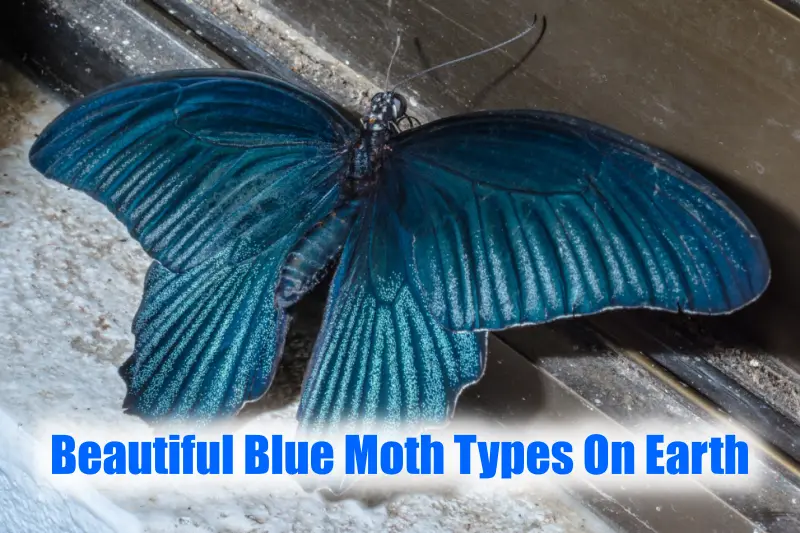People often consider moths not as beautiful as butterflies. However, moths are more beautiful than we realize or anticipate. You will be astounded by the multitude of color variants that they come in.
In this article, we will look at the most beautiful blue moths that are found in nature. Not only their colorations but also their behavior are captivating. You will lose interest in butterflies as you learn more about these amazing animals.
Now let’s begin with a list of the top 15 species of blue moths on Earth.
15 Beautiful Blue Moth Types On Earth
1. Nine-Spotted Moth
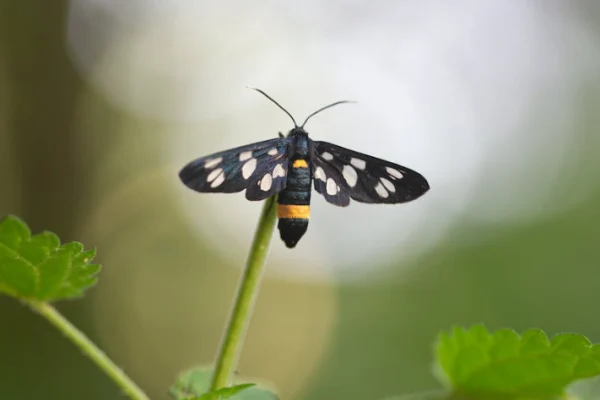
- Scientific name: Amata phegea
- Identification: have white-spotted blue wings
This southern European native species is known for its striking blue appearance. These blue moths look more alluring with their white-spotted metallic blue wings.
They have yellow-colored 2nd or 6th segments of the abdomen.
They exhibit aposematism, which means they mimic Zygaena ephialtes in appearance and can easily protect themselves from predators.
One can easily spot them from May to August during the daytime.
2. Polka-Dot Wasp Moth
- Scientific name: Syntomeida epilais
- Identification: have shiny blue wings with white spots on it
Introducing the polka-dot wasp moth, a wasp mimic. They are distinguished by their shiny blue wings or bodies and crimson abdomen.
Throughout South and Central America, wasp moths like these are often encountered.
Their 45 to 51 mm wingspan and the white spots covering their entire body make them both thrilling and seductive.
Ultrasonic acoustic signals are often used by females to entice males for mating. They also exhibit ravenous hunger in their oleander caterpillar.
3. Edward’s Wasp Moth
- Scientific name: Lymire edwardsii
- Identification: have an orange head
Lymire edwardsii, also known as Edward’s wasp moth, is found in North America, from southern Florida to Vero Beach.
You will find the appearance of this species of moth very appealing, with its bluish-gray wings, blue abdomen, and orange head.
Their caterpillars are known as rubber tree caterpillars because they highly affect rubber trees.
Their larvae are covered with tufts of whitish-yellow setae, except for the brown tuft on the first abdominal segment.
4. Scylla Firetip
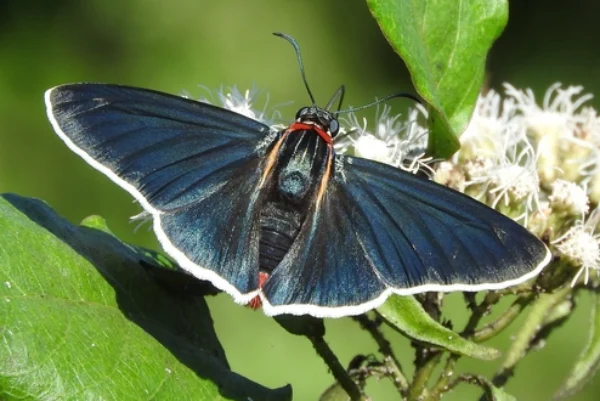
- Scientific name: Elbella scylla
- Identification: Have white margins on their blackish blue wings
Next on our list of blue moths is Scylla Firetip, which is commonly found in North and Central America, from Mexico to Costa Rica.
Let’s talk about appearance first, so these moths exhibit sexual dimorphism.
Primarily, these moths have blackish-blue wings with white margins, which give them a captivating look.
5. Blue Day Moth
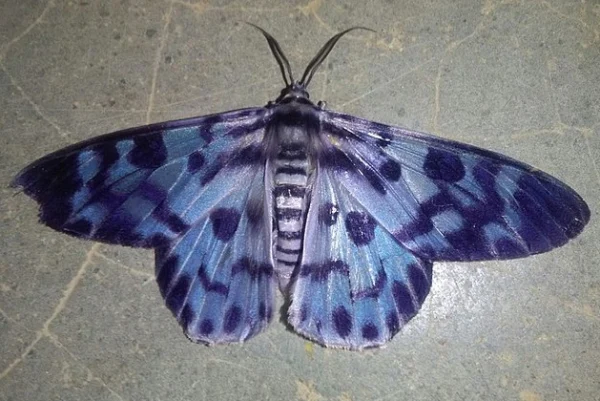
- Scientific name: Dysphania palmyra
- Identification: Have dark blue lines and stripes on their light blue wings
The blue day moth or the long blue tiger moth are some of the common names of Dysphania palmyra, which belongs to the Geometridae family.
They are widely distributed throughout South Asia, mainly in India and Sri Lanka.
These moths are exceptions in the moth world; they are active in daylight.
People often mistake them for butterflies because of their bright coloration.
You’re taken aback by the light blue background with dark blue lines and stripes.
6. Jasmine Moth
- Scientific name: Palpita vitrealis
- Identification: Have a broad orange border on the upper edge of their forewings
The jasmine moth, our next moth, is shown here. As their name implies, these moths are elegant and gorgeous. Because of their appearance, they are also known as white pearls.
They are found throughout Asia, Europe, and Africa. Their wings are transparent with a blue sheen.
The most distinctive feature of these moths is the broad orange border on the upper edge of their forewings.
Both short and long-term migrations are seen in these creatures. They feed primarily on the leaves of jasmine, privet, European olive, etc.
7. Blue Tiger Moth
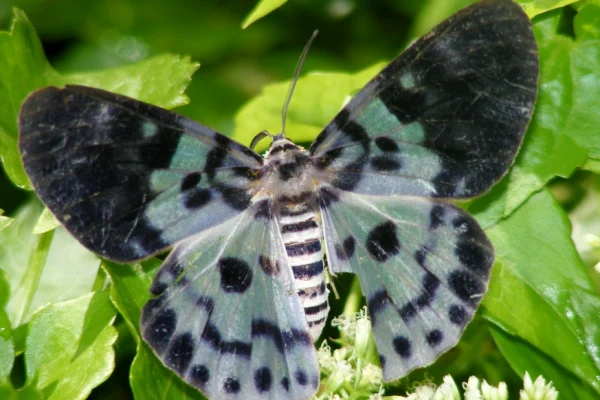
- Scientific name: Dysphania percota
- Identification: Have blue patterns on their light blue wings
Here we have another member of the Dysphania genus, Dysphania percota. This Indian species is known for its unique color combination of black, white, blue, and black.
They may confound you because of how similar they seem to blue-day moths. However, their spot pattern differs greatly from theirs.
Black forewings with black sections on the hindwings make them distinct yet captivating.
The same coloration is also seen in their caterpillars. Carallia is the primary food source for their larvae.
8. Pompelon marginata
- Scientific name: Pompelon marginata
- Identification: Have blue vein patterns on black wings
This diurnal species of moth is also mistaken for a butterfly due to its bright blue and black coloration.
One can find them in Southeast Asia. Pompelon marginata is iridescent blue in color, which makes it visually striking.
They are considered the major pest of laurel trees, on which they feed gluttonously on their leaves.
Their wings have a blue vein design on a black background. In addition to being aposematism, their caterpillars emit a sticky substance that deters caterpillars from other species.
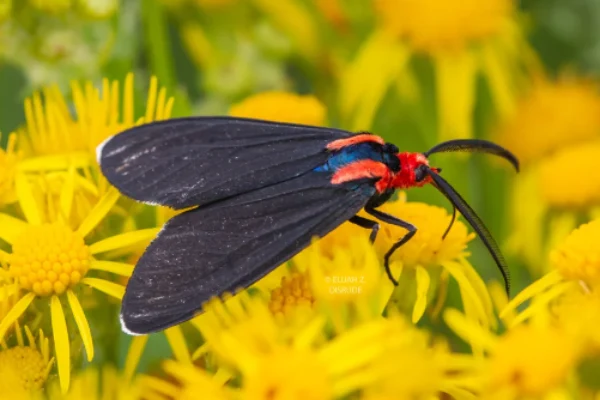
- Scientific name: Ctenucha rubroscapus
- Identification: Have redhead and tegulae
I remember seeing the image of this moth and wondering if it was a grasshopper, a moth, or a butterfly. Since they resemble these three. Their wide wings give them the appearance of a moth or butterfly, and their body structure resembles that of a grasshopper in several ways.
So let me tell you that these moth species are commonly found in Western North America. Their wings are blackish blue in color with a white tip, which gives them their common name.
Their vivid red tegulae and heads are quite recognizable. They are also referred to as red-shouldered Ctenucha moths. Their caterpillars are pure white with a lustrous golden brown, in contrast to their vibrant coloring.
10. Faithful beauty
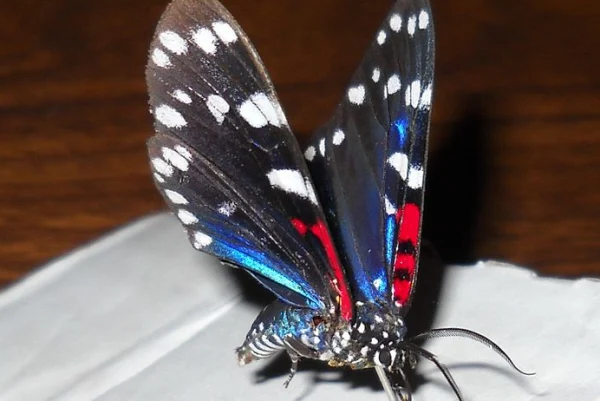
- Scientific name: Composia fidelissima
- Identification: Have red color patterns on the top of their forewings
These moths, which have a wingspan of 4.8 to 6.4 cm, are incredibly vivid and may unintentionally draw your attention.
Known as faithful beauty as they are consistent and reliable in appearance in the same locations in the same year, they are being faithful to visitors to these areas.
You can find these day-flying moths in South Florida. They are one of the largest moth species in America.
Their appearance is as follows: the top parts of the forewings are colored red, and they have sporadic white patches all over their dark blue body.
11. Western Grapeleaf Skeletonizer Moth
- Scientific name: Harrisina Metallica
- Identification: have a dark blue body and wings
These Western Grapeleaf Skeletonizer Moths, or Harrisina Metallica, are commonly found in the southwestern United States, including California, Texas, Utah, Colorado, Northern Mexico, etc.
They are regarded as pests and mostly eat on grape leaves, which is how they received their common name.
Their entire body, including their wings, is a deep shade of blue.
12. Blue underwing
- Scientific name: Catocala fraxini
- Identification: Have blue bands and white margins on their hindwings
Linnaeus was the first to describe Catocala fraxini, which goes by several common names, including blue underwing and Clifden nonpareil.
When you see them in their wings, you will say I don’t like these dull colors, but when they open up their wings, they surely are going to amaze you to the core.
The brownish-gray forewings of these moths, which aid in their concealment, contrast with their black wings with blue bands and white edges.
Although they are found all across the world, they are most abundant and ubiquitous in Europe.
13. Virginia Ctenucha Moth
- Scientific name: Ctenucha virginica
- Identification: Have a bright orange body and blue body
Are you curious, as I’m curious about the next species? So let’s meet the Virginia Ctenucha moth, which is the most common moth species in Eastern North America, from Newfoundland south to Virginia.
These medium-sized moths have an average wingspan of 40–50 millimeters and exhibit a beautiful metallic blue-green coloration.
Their wings are black, just like those of other Ctenucha moths, and they have a characteristic blue head.
14. Green Forester Moth
- Scientific name: Adscita statices
- Identification: exhibit blue coloration in sunlight
You’re probably wondering why I put the green forester moth on the list of blue moth species. Let me tell you why. There is a reason: these green forester moths show a beautiful blue hue on their green bodies in direct sunlight.
One can find them in Europe, Mongolia, and western Russia.
Some pores are present on their wings that are filled with water, which causes the scales to change color. You can see them flying in June and July during the daytime.
15. Narrow-bordered Five-spot Burnet
- Scientific name: Zygaena lonicerae
- Identification: Have five red spots on their wings
Last but not least on our list of blue moths are narrow-bordered five-spot burnets.
As the name clearly indicates, they have five red spots on their wings, which makes them stand out in the crowd.
They commonly inhabit dry habitats like grasslands, woodland rides, and post-industrial brownfield sites such as quarries and spoil heaps.
Conclusion
Here we conclude our article on the 15 most beautiful blue moth species found on earth.
These blue moths are not only visually unique but also behaviorally unique and very intriguing.
I used to think that moths were nocturnal only, but after searching for these creatures, I got to know that some of them are diurnal as well and so colorful that people often get confused with butterflies.
I hope you find this article on blue moths interesting and engaging.
Also Read:

Being a zoology student I’m always been fascinated toward animals especially insects. I love to do research and learn about different animals. As a writer I want to share my thoughts about nature through my articles. Apart from this you can find me exploring the new places and voice notes.
